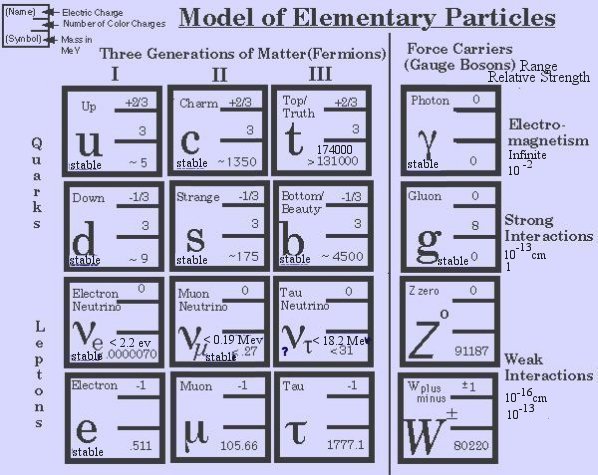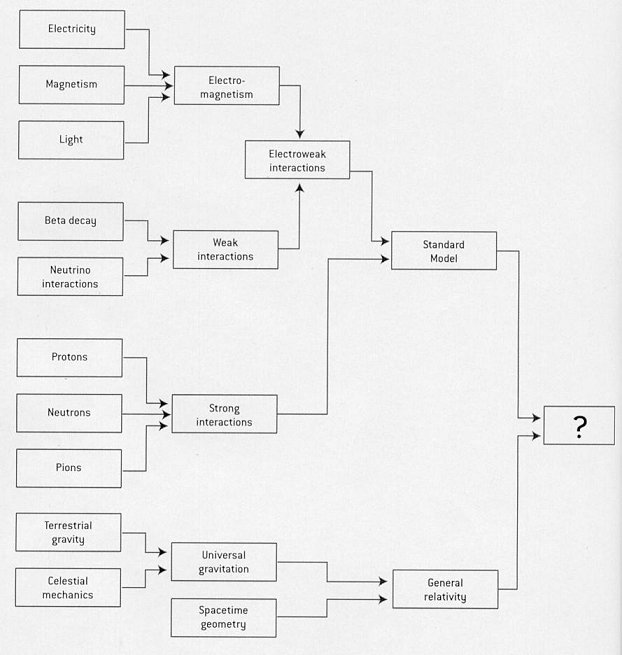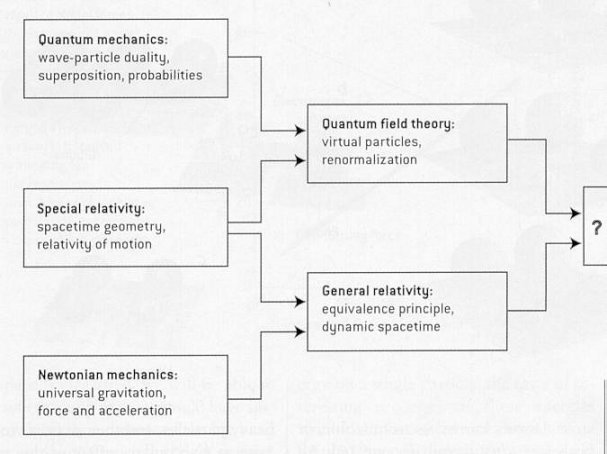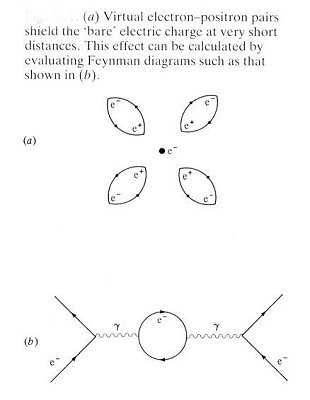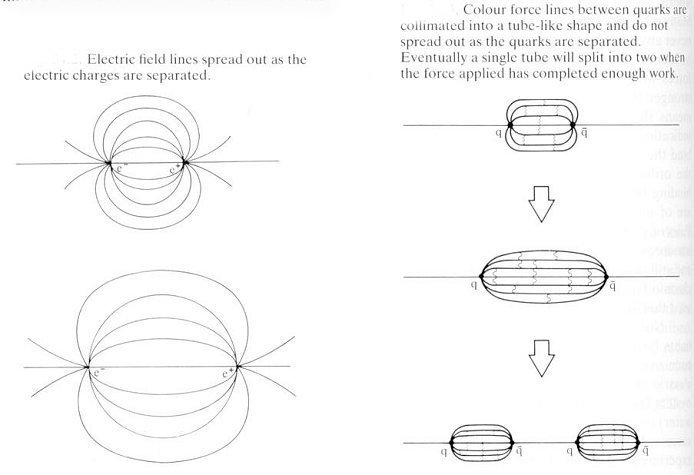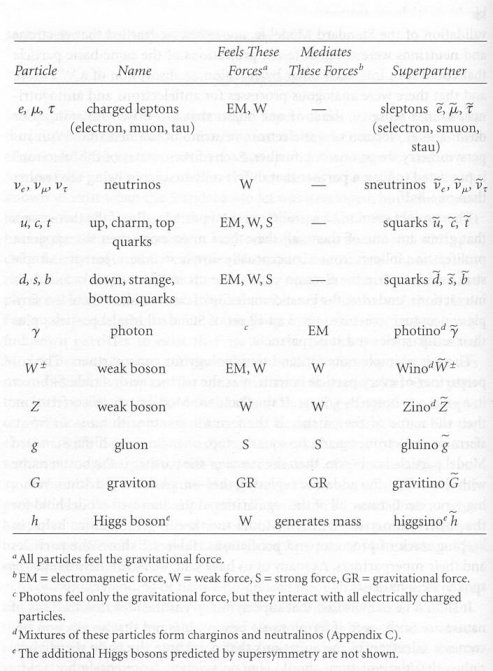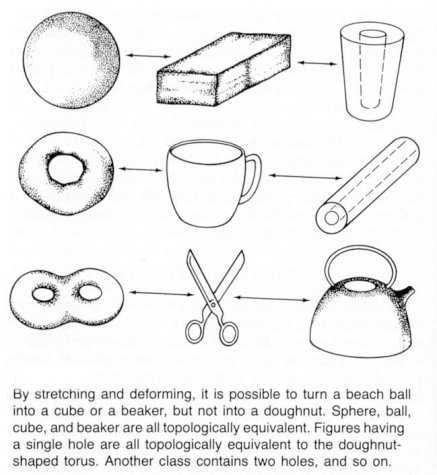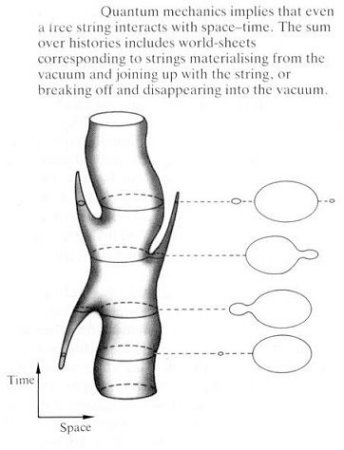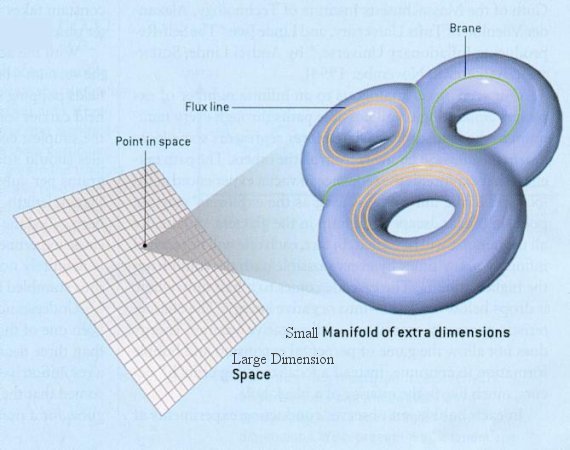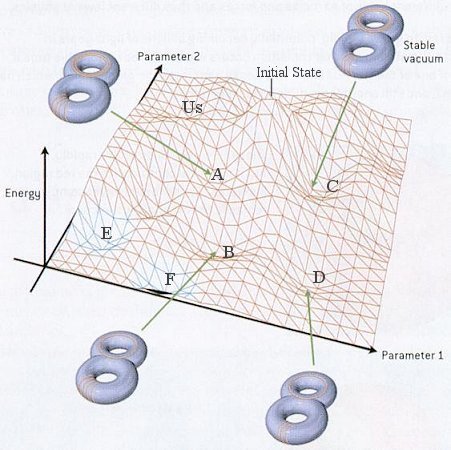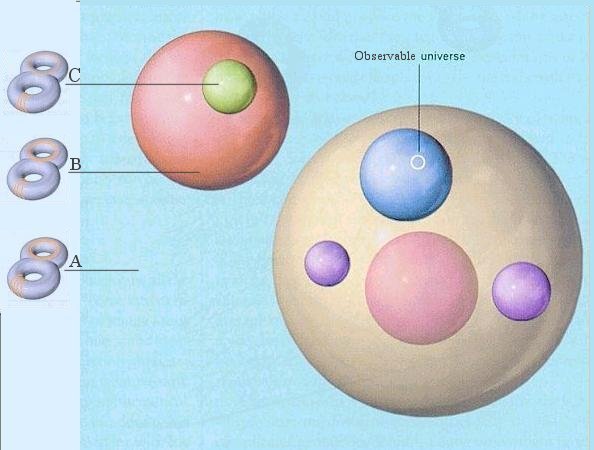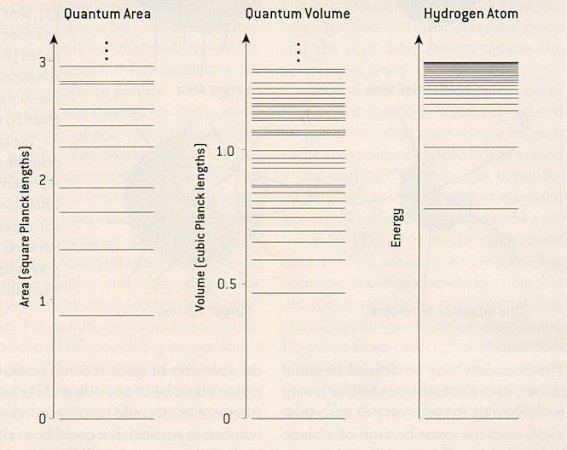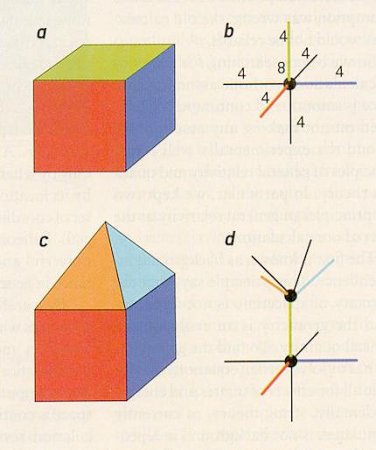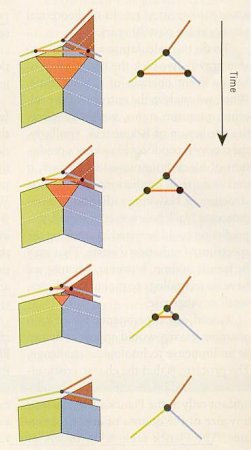Elementary Particles
Contents
Quantum Domain and
Accelerators
Elementary Particles
Fundamental Interactions
Unifications, A Brief History of Physics
Quantum Field Theory
Gauge Theory and the Standard Model
Grand Unified Theory (GUT)
Asymptotic Freedom
Quark Confinement
Supersymmetry
Superstrings
Manifold, Vacuum Energy, and Multiverse
Quantum Foam and Loop Quantum Gravity
Footnotes
References
Index
Quantum Domain and Accelerators
 |
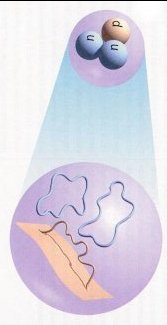 |
Figure 15-01 shows the size of the systems, which are governed by the rules in quantum theory. It starts from molecule with a size of 10-7cm to the hypothetical entity of string and membrane, which has a size of only 10-33cm. Figure 15-02 shows a proton composed of two up quarks and one down quark. According to the superstrings theory, these quarks are loops of string or string attached to a membrane at the scale of less than 10-33cm, which is called the Planck scale - the smallest meaningful size (see Quantum foam). |
Figure 15-01 Quantum Domain |
Figure 15-02 String & Membrane |
Particle accelerators were invented to investigate objects with size less then 10-12 cm. Accelerators are to particle physics what telescopes are to astronomy, or microscopes are to biology. These instruments all reveal and illuminate worlds that would otherwise remain hidden from our view. They are the indispensable tools of scientific progress. The earliest accelerators were simple vacuum tubes in which electrons were accelerated by the voltage difference between two oppositely charged electrodes. From these evolved the Cockcroft-Walton and van de Graaff machines, larger and more elaborate, but using the same principle. The modern example of this type of device is the linear accelerator, a sophisticated machine used in many scientific and medical applications. All such straight-line accelerators suffer from the disadvantage that the finite length of flight path limits the particle energies that can be achieved.
The great breakthrough in accelerator technology came in 1920 with Ernest O.
Lawrences invention of the cyclotron. In the
cyclotron, magnets guide the particles along a spiral path, allowing a single
electric field to apply many cycles of acceleration. Soon unprecedented energies
were achieved, and the steady improvement of Lawrences simple machine has led
to todays proton synchrotrons (PS), whose endless circular flight paths allow protons to gain
huge energies by passing millions of times through the electric fields that
accelerate them.
Until twenty-five years ago, all accelerators were so-called fixed-target machines, in which the speeding particle beam was made to hit a stationary target of some chosen substance. But early in the 1960s physicists had gained enough experience in accelerator technology to be able to build colliders, in which two carefully controlled beams are made to collide with each other at a chosen point. Several colliders exist around the world today, and the technology for them is by now well established. Colliders are more demanding to build, but the effort pays off handsomely. In a fixed-target machine, most of the projectile particles continue the forward motion with the debris after impact on the target. In a collider, on the other hand, two particles of equal energy coming together have no net motion, and collision makes all their energy available for new reactions and the creation of new particles.
It is realized that the mass-energy relation (E = mc2) provides a new way to get information about particles. If particles could be made very energetic and then used to collide with other particles, some of their energy could be converted into the creation of previously unknown particles. When particles are produced in a collision, they are not particles that were somehow inside the colliding ones. They are really produced by converting the collision energy into mass, the mass of other particles. Which particles will be produced is partly determined by their mass - the lighter they are, the easier it is to produced them, other things being equal - and also by the probabilities calculated from the Feynman diagram.
Particle with energy about 1 Gev (109 ev) is required to probe the structure inside proton. Higher energy is required for smaller system - about 1000 Gev is needed to probe into the quarks. The same amount of energy is required to create many of the hypothetical particles. Currently, the Fermilab's Tevatron has enough energy to produce the top quark (~170 Gev). Up to 14 Tev (1012 ev) will be available by the LHC (Large Hadron Collider) at CERN in 2007. Table 15-01 below summarizes some features of the major accelerators in the world (all of them are colliders):
| Accelerator | Colliding Particles | Total Energy | Major Accomplishment |
|---|---|---|---|
| Stanford Linear Collider (SLC) in Palo Alto | electron, positron | 100 Gev | provided first look at Z0 |
| Large
Electron Positron Collider (CERN-LEP) in Geneva |
electron, positron | 200 Gev | discovered Z0, W+ - in 1983; shut down in 2002 |
| Relativistic Heavy Ion Collider
(BNL-RHIC) in Brookhaven |
heavy ions | 200 Gev | created quark-gluon plasma (little Big Bang) |
| Tevatron (FNAL) in Chicago | proton, antiproton | 2 Tev | confirmed Z0, W+ -, discovered top quark |
| Large
Hadron Collider (CERN-LHC) in Geneva |
proton-proton; ion-ion | 14 Tev | planned for 2007 - LEP replacement |
Table 15-01 High Energy Accelerators
Note 1: CERN = European Organization for Nuclear Research, BNL = Brookhaven
National Laboratory,
FNAL = Fermi National Accelerator Laboratory.
Note 2: Cosmic rays
are energetic particles come from outer space. Before the development of
particle accelerators, cosmic rays provided physicists with their only source of
high-energy particles to study. Although low-energy cosmic rays are emitted from
the Sun, the origin of the highest energy cosmic rays is one of the outstanding
puzzles in astrophysics. These particles (mostly protons, but including heavier
atomic nuclei) have energies of up to 108 TeV. We can only speculate
about the conditions at the source of the cosmic rays, because we know of no
standard object (supernova, pulsar, or even a black hole) that could easily
accelerate particles to such enormous energies.
Elementary Particles
- The mass of the particles are listed on the lower right-hand corner in unit of Mev. Some new data are added on top of the older ones if new experimental results are available. On the lower left-hand corner the member is labeled as stable or otherwise with blank space. The three fermion generations appear to be a mini-version of the periodic table if the chart is re-arranged as shown in Table 15-02 (Table 15-02a is a pictorial view). Then it becomes apparent that the mass of the fermions increases from left to right and the most stable members are on the top row with decreasing stability for the next two rows. This outline is somewhat similar to the chemical periodic table.
- Each member in the fermion generations has its own anti-particle with opposite electric charge and/or colour charge, e.g., the anti-particle of electron is the positron with one unit of positive charge and identical mass.
- The electric charge for quarks appears to be either -1/3 or 2/3. However, when three of them combine to form a baryon (fermion affected by strong interaction); it is always in such a way that the total charge is +2, +1, 0, or -1. When a quark and anti-quark combine to form a meson (boson affected by strong interaction); it is always in such a way that the total charge is +1, 0, or -1.
- Each quark can carry either one of the three varieties of colour charge -- red, green, and blue. This is just a label (a name) and has nothing to do with optics. In order to form a baryon the three quarks must each carry a different colour to add up to white. While in a meson the colour would be balanced by the anti-colour (such as red and anti-red).
- The force carriers are gauge bosons, which mediate the various kinds of interaction between the fermions. While photon does not carry electric charge, the gluons and the W bosons do carry colour charge, and electric charge respectively.
- The gauge bosons with mass are unstable. With just two exceptions, those elementary particles having mass over the range of Gev tend to be unstable.
| Symbol Name, Electric Charge, # of Colour Charges Stability, Mass (in Mev) |
| Generation 1 | Electron Neutrino, 0, 0 Stable, < 0.0000022 |
Electron, -1, 0 Stable, 0.511 |
Down Quark, -1/3, 3 Stable, ~ 9 |
Up Quark, +2/3, 3 Stable, ~ 5 |
| Generation 2 | Muon Neutrino, 0, 0 Stable, < 0.19 |
Muon, -1, 0 Unstable, 105.66 |
Strange Quark, -1/3, 3 Stable, ~ 175 |
Charm Quark, +2/3, 3 Stable, ~ 1350 |
| Generation 3 | Tau Neutrino, 0, 0 ?, < 16.2 |
Tau, -1, 0 Unstable, 1777.1 |
Bottom Quark, -1/3, 3 Stable, ~ 4500 |
Top Quark, +2/3, 3 Unstable, ~ 178000§ |
§Latest measurement in 2004.
Table 15-02 Fermion Table (A Different View)
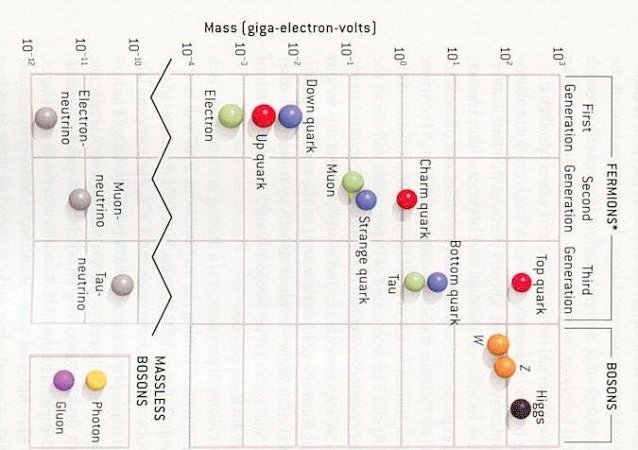 |
Table 15-02a Fermion Table (A Pictorial View)
Fundamental Interactions
- There are four fundamental interactions act on the different charge carriers. These are the gravitational with mass-energy, the electromagnetic with electric charge, the weak and strong interactions with flavor and colour charges.

- The electromagnetic and weak interactions are unified at high energy into the electroweak interaction.
- The strong residual interaction is experienced by hardons (all the particles affected by the strong nuclear force) and generated by the quarks within. It is strong enough to overcome the electromagnetic repulsion between the hardons. This is similar to the Van der Waals force between molecules (except the difference in charge carrier).
- The strengths of the various interactions in Figure 15-04 are relative to the electromagnetic interaction. It depends on the separation between the two particles. At a separation of 10-18 m. the electromagnetic and weak forces mixes to generate two new electroweak forces. According the the Grand Unified Theory (GUT), these electroweak forces merge with the strong force at 10-32 m.
- The strength for gravitational interaction is very weak at small separation. Its force carrier, the graviton, has not yet been detected. This interaction is poorly understood in domain of very small scale. One explanation relates the weakness of gravity to its leakage to other dimensions in a manyfold universe.
Unifications, A Brief History of Physics
- Thermodynamics is the oldest branch of physcis developed in 19th century. It began with the invention of the steam engine at the beginning of the industrial revolution. It was driven by the need to have a better source and more efficient use of energy than the competitors (among English, French, and German). It was a case where technology drove basic research rather than vice versa. Thermodynamics provides a macroscopic description of matter and energy. Today better insight is obtained by linking the subject with microscopic particles.
- The electric and magnetic fields were described in terms of the Coulomb's Law (about charge and electric field), the Ampere's Law (about current and magnetic field), and the Faraday's Law (a relationship between electric and magnetic fields). Faraday's observation has inspired J.C.Maxwell to assemble these laws into a consistent set of equations in 1865 and is now known as Maxwell's equations. The disturbance of the electromagnetic fields was subsequently identified as the light wave in optics.
Enrico Fermi:
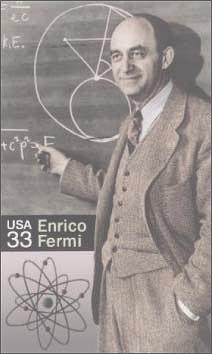 |
Hideki Yukawa: | ||||
 |
|||||
|
|
|||||
-
 Beta
decay
was a main topic of research in the first decades of the 20th
century. It was found that the electrons produced in the decay has energy
always less than the 1.5 me available when the neutron transmutes
into a proton. It was Wolfgang Pauli who came up with the answer in 1930. He
surmised that there must be another particle running away with the "missing
energy". The particle required to do the job must have zero mass and no
electric charge to escape detection by the experimenters. In 1933 Enrico
Fremi took up
Pauli's idea and put it on a respectable footing by introducing a new force
called "weak" interaction. The hypothetical particle is called
neutrino. He
proposed that when a neutron changes into a proton it emits a mediating boson
called W-, which carries off the negative electric charge and
excess energy, while the neutron changes into a proton and recoils. The W-
boson then quickly decays into an electron and an anti-neutrino. Evidence for
the existence of the neutrino came in 1953. The W- boson was
discovered in 1983.
Beta
decay
was a main topic of research in the first decades of the 20th
century. It was found that the electrons produced in the decay has energy
always less than the 1.5 me available when the neutron transmutes
into a proton. It was Wolfgang Pauli who came up with the answer in 1930. He
surmised that there must be another particle running away with the "missing
energy". The particle required to do the job must have zero mass and no
electric charge to escape detection by the experimenters. In 1933 Enrico
Fremi took up
Pauli's idea and put it on a respectable footing by introducing a new force
called "weak" interaction. The hypothetical particle is called
neutrino. He
proposed that when a neutron changes into a proton it emits a mediating boson
called W-, which carries off the negative electric charge and
excess energy, while the neutron changes into a proton and recoils. The W-
boson then quickly decays into an electron and an anti-neutrino. Evidence for
the existence of the neutrino came in 1953. The W- boson was
discovered in 1983. - It was well aware in the 1930s that the force that hold the neutrons and protons together in the nucleus has to be short-range, extending only over about the diameter of a nucleus, otherwise it would pull all the nuclei in everything together. In 1935 Hideki Yukawa suggested that the strong nuclear force must be mediated by the exchange of another kind of force-carrying particle, which became known as pion. His explanation for the short range of the force is related to the ucertainty principle . If the pion has mass, then its virtual existence can last only for a short time. He estimated the mass of the pion to be 150 Mev. The actual mass is 140 Mev when it was discovered in 1947. It is now known that the pion is a composite boson, it is not truly a fundamental force carrier.
- One of the greatest triumphs of theoretical physics in the second half of the 20th century was the discovery, made independently by Abdus Salam and by Stewen Weinberg in 1967, of a way to describe the weak interaction and the electromagnetic interaction in one mathematical formalism, as a single force - the electroweak interaction (based in part on work developed previously by Sheldon Glashow). The theory requires three intermediate vector bosons with mass to explain the weak interaction. The predicted masses of these bosons were duly observed in experiments at CERN in the early 1980s. A scalar field called the Higgs field is introduced in this formalism to endow mass to the gauge bosons Zo, W+, and W-. The mass of the Higgs boson is estimated to be between 63 and 800 Gev. At present, there is no experimental evidence in favor of a Higgs boson, nor is there any against.
- A similar formalism was developed for the strong interaction in the 1970s. The story starts with three doublets of quark flavors (u, d), (c, s) and (t, b). (See Figure 15-03.) It turns out that there are not just six but eighteen distinct quarks, distinguished from each other by colour charge. Each quark comes in three colour charges -- red, green, and blue. A postulated symmetry between these three colour charges would given rise to eight gauge bosons -- called gluons, which remain massless (no Higgs field interaction is necessary). Detailed tests have supported the idea of the strong interaction being mediated by the gluons. This formalism is called Quantum Chromodynamics (QCD). Together, the electroweak theory and QCD constitute what has become known as the "Standard Model" of elementary particles.

- Around 1680 Isaac Newton asserted that the force of "terrestrial" gravity (which makes apples fall to the ground, and which in Newton's view was a universal force) was the same as "celestial" gravity (the force which keeps planets in motion around the Sun). Such a force is long-range. Its effects can be felt at any distance, though attenuated by the square of the distance between the two "gravitating" objects concerned. Newton introduced a new fundamental constant of nature, G, which characterizes the strength of the gravitational force. Gravity is always attractive in contrast to other forces of nature. Newton's formalism works in a three dimensional Euclid space (flat space). Time is independent of the system of reference -- it is just a running variable. An invariance in such space is the length. It is the same in any coordinate system. Other consequences derived from Newton's formalism include action at the distance, i.e., there is no time delay for the two "gravitating" objects to interact; and determinism, which assumes that events are entirely determined by other, earlier events.
 |
- In 1887 Michelson and Morley showed conclusively that the velocity of light is constant in all inertial systems of reference. This observation led Einstein to propose the principle of relativity in 1905. This is also known as the Special Theory of Relativity, which treats space and time on an equal footing such that the velocity of light is constant in this four dimensional space-time. It implies that space and time can transform among each other in different inertial systems of reference. In particular, time ticks slower and length becomes shorter in a fast moving reference frame (with respect to the observer). Another consequence is the finite propagation of interaction, the signal can travel from object A to B only with a speed less than or equal to the velocity of light. These ideas are in complete variance with the Newtonian Mechanics. However, classical mechanics is still a good approximation for phenomena involving low velocity (in comparing to the velocity of light).
- Starting from the principle of equivalence, which states that the properties of the motion in a non-inertial (accelerating) system is the same as those in an inertial (non-accelerating) system in the presence of a gravitational field, Einstein proposed the General Theory of Relativity in 1915. In general relativity, it is postulated that the curvature of space-time determines gravity. The mass-energy generates the curvature of space-time and particles moving along the geodesic in this four dimensional curved space. The geodesic is the shortest distance between two points. It is a straight line only in Euclidean space (flat space); it would be different in the curved space (Riemann space).
Quantum Field Theory
It has been mentioned in Topic 12 that the transition from classical to quantum mechanics can be accomplished either by the path integral method or by the more ad hoc "canonical quantization" such that the momentum p and position q are no longer mere numbers but are operator satisfying the commutative relation: pq - qp ~ h. The Schrodinger equation was developed and applied to the atomic and molecular system with great success. This formalism becomes increasingly inaccurate for phenomena in smaller domain where energy can manifest itself in a variety of ways, e.g., pair creation or particle moving at relativistic speed. Therefore, the Schrodinger equation has to be replaced by field equations such as the Klein-Gordon equation (for particle with no spin) or Dirac equation (for particle with spin 1/2). These field equations are invariant (unchanged) under a change of the space-time coordinate system (Lorentz transformation). It is referred to as relativistic invariance, which ensures the validity of the field equation at relativistic speed. To account for the creation/annihilation of particles in high energy interaction, the field is considered to be an operator. It is expanded into Fourier series in terms of harmonic functions and coefficients. These coefficients are then subjected to some quantization rules. Depending on whether the particle has integer or half integer spin, these operators satisfy the commutation or anti-commutation relations (for example: ab + ba = 1; the Pauli exclusion principle is guaranteed by quantization with the anti-commutation relations for spin 1/2 particles). They are the creation and annihilation operators, which operate on state vectors describing the number of particles in different states. This is called the second quantization, which endows particle property to the field (field + second quantization = quantum field). Thus, in quantum field theory the particles are just bundles of energy and momentum of the fields, which constitute the basic ingredient. A more mathematically oriented description on Quantum Field Theory can be found in the appendix.
Before performing the second quantization, a field equation has to be available to describe the dynamic of the field. It is found that the field equation is equivalent to minimizing the "Action", which is now a function of the field and its first derivative. Since there is an infinite choice for the form of the "Action", some conditions are imposed to limit the arbitrariness. For example, the "Action" should be invariant (unchanged) under the operation of translation, rotation, and time progression (these kinds of symmetry imply the conservation of momentum, angular momentum, and mass-energy respectively). However, the symmetry of the "Action" or the field equation does not guarantee the same for its solution. For example, the Schrodinger Equation (mentioned in topic 12) have rotational symmetry for the hydrogen atom, and yet only the wave function corresponding to zero angular momentum possesses a spherical configuration. (See Figure 12-07.)
Gauage Theory and the Standard Model
The modern theory of elementary particles depends heavily on the concept of gauge invariance, which was used to describe some global changes that do not have any effect on observation. For example, if the electric voltage throughout the circuit is raised uniformly by the same amount, there would not be any observable effect. But locally at a specific space and time, when a disturbance happens to a fermion field for example, something will react to restore the original "appearance". That something turns out to be the gauge bosons mentioned earlier in Figure 15-03. For example, in the electromagnetic interaction a local disturbance can be considered as a two dimensional rotation of the quantum field (which is usually a complex function) in an "internal space". The photon (the gauge boson) is the response to restore the "appearance", which signifies mathematically the invariance of the "Action" with this internal rotation. Theoretical physicists are fond of putting similar objects together called a group. For the case of electromagnetic interaction, there is only one kind of objects -- the two dimensional internal rotation. The different rotational displacements form a group, this particular group is called U(1). The symbol U indicates that the transformation (the internal rotation) is unitary, which preserves the normalization (probability). This U(1) group has the property that the internal rotation operations are commutative -- mathematicians call such kind of group an Abelian group. Similar gauge invariances exist for the strong and weak interactions, the "internal rotation" depends on more than one parameter in these cases. Group of objects can be formed from these generalized "rotational displacements". However, these elements are no longer commutative. Such groups are called non-Abelian. The gauge theory for the U(1) is called Quantum Electrodynamics (QED).
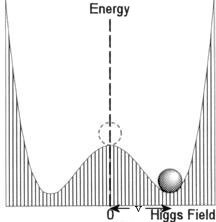 The non-Abelian group called
SU(2) is applicable
to the case of weak interaction. The internal rotation is generalized to three
parameters corresponding to three different gauge bosons -- W+, W-,
and Z0. The participating particles are the left-handed
pair of leptons. In the Weinberg-Salam model, the left-handed leptons can
undergo both electromagnetic and weak interactions while the right-handed
electron can only participate in electronmagnetic interaction. Thus the model
unifies these two interactions. This asymmetry in
chirality is
related to the phenomenon of parity violation
in weak interaction, and has been verified conclusively in the 1950s. The
electroweak unification occurs at energy above 102 Gev. A
complication arises with regards to the mass of gauge bosons for which, the
original Yang-Mills theory
failed to account for. In the modern version, the mass is generated with a
process called the Higgs mechanism, which proposes that some scalar fields
called the Higgs fields exist in the vacuum. In the mathematical formalism these
Higgs fields are added to the "Action" for the electroweak interaction. At the
transition temperature (happened early in the Big Bang), these Higgs fields
move to more stable states in lower energy level. Once this happens, all the
particles (both bosons and fermions) would acquire mass by interacting with the
Higgs condensates. There is now a convincing consensus of experimental results
supporting this electroweak theory.
The non-Abelian group called
SU(2) is applicable
to the case of weak interaction. The internal rotation is generalized to three
parameters corresponding to three different gauge bosons -- W+, W-,
and Z0. The participating particles are the left-handed
pair of leptons. In the Weinberg-Salam model, the left-handed leptons can
undergo both electromagnetic and weak interactions while the right-handed
electron can only participate in electronmagnetic interaction. Thus the model
unifies these two interactions. This asymmetry in
chirality is
related to the phenomenon of parity violation
in weak interaction, and has been verified conclusively in the 1950s. The
electroweak unification occurs at energy above 102 Gev. A
complication arises with regards to the mass of gauge bosons for which, the
original Yang-Mills theory
failed to account for. In the modern version, the mass is generated with a
process called the Higgs mechanism, which proposes that some scalar fields
called the Higgs fields exist in the vacuum. In the mathematical formalism these
Higgs fields are added to the "Action" for the electroweak interaction. At the
transition temperature (happened early in the Big Bang), these Higgs fields
move to more stable states in lower energy level. Once this happens, all the
particles (both bosons and fermions) would acquire mass by interacting with the
Higgs condensates. There is now a convincing consensus of experimental results
supporting this electroweak theory.
When the internal rotation is generalized to
SU(3), The gauge
theory can be applied to the case of strong interaction. There are eight
parameters for this group corresponding to eight gauge bosons called gluons. The
participating particles are the quarks with 3 different colour charges -- red
(r), green (g), and blue (b). Three quarks with different colour charges combine
to form a baryon. Each quark can carry different colour charges at different
time, provided the colour combination is "white". Unlike the case of the U(1)
group where the gauge boson (the photon) does not carry charge, the gluons do
themselves carry the colour charges. Such difference produces phenomenon such as
asymptotic freedom and quark confinement. The gauge theory for the SU(3) group
is called Quantum Chromodynamics (QCD). The formulism for QCD and electroweak
interaction together is known as the
Standard Model,
which describes all the phenomena associated with leptons and quarks.
Asymptotic Freedom
Quark Confinement
Grand Unified Theory (GUT)
Although the Standard Model has been very successful in accounting for all experimental phenomena, it is not expected to be the ultimate theory because of its great complexity and the many questions it leaves unanswered. These objections seem to suggest that there may be deeper symmetries underlying the standard model, leading perhaps to the unification of the strong and electroweak interactions into a single "Grand Unified theory", or GUT. Such scheme is indeed possible if the internal rotation group is further generalized to SU(5) with 24 parameters. All the elementary particles are assigned into
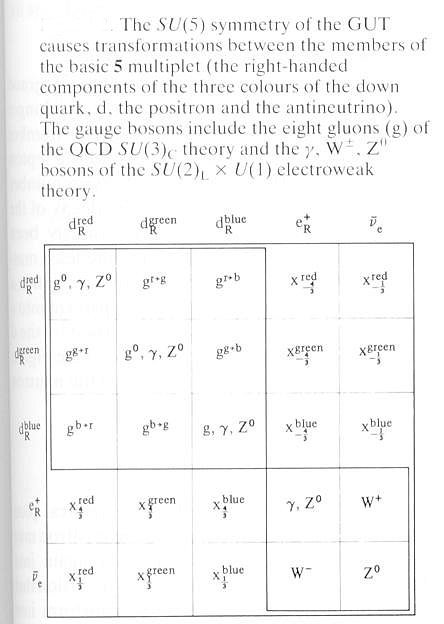 |
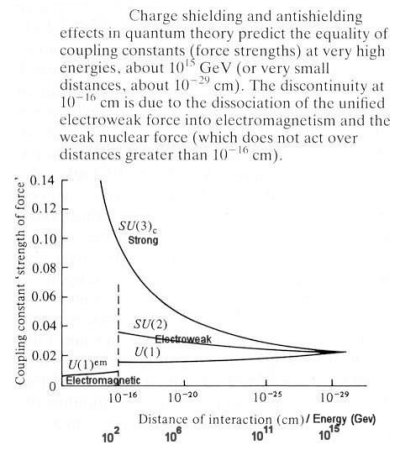 |
two 5-multiplets and two 10-multiplets. Figure 15-10 shows one of the 5- multiplets with the 24 gauge bosons assignment arranged into a matrix. Of these, 12 are familiar (the photon, W+, W-, Z0 and 8 gluons). The remaining 12 are new bosons denoted by X; these carry new forces which can transform quarks into leptons and vice versa. The mass of the X bosons have been calculated under the Higgs mechanism, and turns out to be about 1015 Gev. These super-heavy particles lie many orders of magnitude beyond the energy ranges of any conceivable accelerator. However, they would be present in great abundance in the first 10-35 sec after the Big Bang. |
Figure 15-10 SU(5) Symmetry |
Figure 15-11 Grand Unified Theory |
At energies well above 1015 Gev, all gauge bosons (including the Xs) can be produced freely and all interactions have the same strength and quarks can transform into leptons as easily as they change colours; and the grand SU(5) symmetry is manifest. At an energy of about 1015 Gev, the SU(5) symmetry breaks down to separate SU(3) and SU(2)XU(1) symmetries and the grand unified interaction separates into the strong and electroweak interactions. At about 102 Gev, the SU(2)XU(1) symmetry becomes broken, reflecting the separation of electroweak interaction into the distinct weak and electromagnetic interactions. This picture of the unification of interactions also incorporates the variation in the strengths of charges, depending on the distance from which they are acted upon as shown in Figure 15-11. The most dramatic consequence of grand unification is that the proton is no longer stable, it has a small probability for decay into a neutral pion and a positron (with a half life of about 1031 years). No such decay has been detected so far.
Supersymmetry
Supersymmetry differs from all other symmetries in that it relates two
classes of elementary particles which are so fundamentally different -- the
fermions and the bosons. According to supersymmetry, every "ordinary" particle
has a companion particle -- differing in spin by half a unit, but with otherwise
identical properties. Furthermore, the strengths of the interactions of the
superpartners are identical to those of the corresponding ordinary particle.
is a good approximation. Supersymmetry also addresses a host of other mysteries in modern physics such as the tremendous concentration of energy in the universe (the cosmological constant problem), the origin of cosmic inflation, matter/antimatter asymmetry, the nature of cold dark matter, and the special forms of the Higgs interactions.
If supersymmetry were an exact, unbroken symmetry, the superpartners would have the same mass of the ordinary particles. However, no such particles have ever been observed, and supersymmetry, therefore, if it is a true symmetry of particle physics, must be broken. If the breaking of supersymmetry is in such a way that the explanation for the hierarchy problem is still valid, then the mass of the superpartners would be in the order of 103 Gev -- just at the mass range accessible to the new generation of accelerators.
Superstrings
According to the theory of superstrings, the fundamental constituents of the material world are not point-like elementary particles, but tiny one-dimensional strings having a length of about 10-33 cm (the Planck length). Like the string of a violin, they can vibrate in many different ways (different modes), which correspond to the different elementary particles observed in nature. It is a quantum theory that incorporates gravity naturally. In its larger framework of M-theory, the strengths of all the four fundamental forces merge together at very small distance (~10-33 cm.) as shown in Figure 15-13.
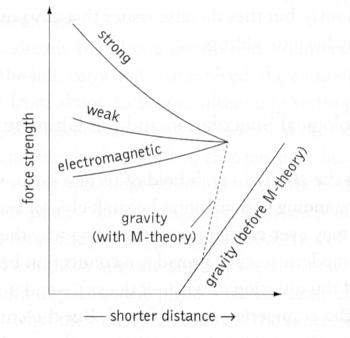 |
 |
There are two classes of strings, those with ends (open strings), and those without (closed strings -- a loop) as shown in Figure 15-14. The particles associated with the open strings are the spin-1 gauge bosons and fermions. Their movement is restricted on the surface of a membrane by some boundary conditions. Graviton with spin-2 is an example of closed string, which can travel freely in all spatial dimensions. These are the ingredients for the theory of manyfold universe. |
Figure 15-13 Super-unifi-
|
Figure 15-14 String, Open & Closed |
When a point particle moves through space-time, it follows a geodesic (a path of minimum length) and sweeps out a one-dimensional curve which is referred to as its world-line. However, when a string propagates through space-time, it sweeps out a two-dimensional surface which, by analogy, is called its world-sheet, and moves along a surface of minimum area. (See Figure 15-14.)
When supersymmetry is incorporated into the original string theory, it resolves the problem with tachyon (square of mass is negative), accommodates the ferminonic vibrational pattern, and merge general relativity with quantum mechanics. The Theory of Strings becomes the Theory of Superstrings.
The "heterotic" superstring theory is a theory of closed strings. In contrast to open strings with gauge charges at the endpoints, here the gauge charges are "smeared" over the entire heterotic string. Vibrations (waves) can travel around any closed string in two directions, but the unusual feature of the heterotic string is that the waves moving in each direction are completely different. The clockwise moving waves are the waves of the 10-dimensional superstring, whereas the waves moving anticlockwise are those of the original 26-dimensional bosonic string. To obtain a consistent 10 dimensional theory, 16 of the extra dimensions are interpreted as internal degrees of freedom, which are found to be related to local gauge symmetry.
 |
|
|
| Figure 15-15 Compactification | ||
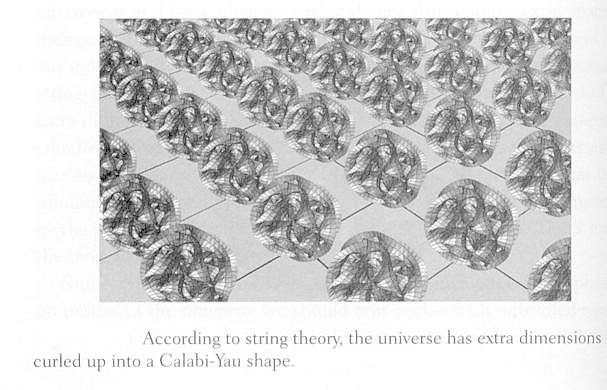 |
||
| Figure 15-16 Calabi-Yau Space |
| A ten-dimensional space is required in order to eliminate ghosts (negative probability) in the formalism. To specify a point in this 10-dimensional space requires the usual four (x, y, z, t), plus an additional six more coordinates. Suppose one of these extra coordinates is curled into a small circle, |
(see Figure 15-15.) its value is now the angle in the circle. Because the radius of the circle is so small (~10-33 cm), the value of the angle is completely unobservable. Consequently, the laws of physics should be invariant under shifts in the angle. This behaviour is reminiscent of the internal rotation mentioned earlier in the U(1) symmetry and they can be identified with each others. Therefore, distortion of this curled-up dimension corresponds to the presence of spin-1 gauge bosons. Actually the compactification is on a six-dimensional space, the theory of superstring severely restrict the geometrical form. It has been shown that a particular class of six-dimensional geometrical shapes called Calabi-Yau spaces can meet these conditions. Figure 15-16 shows the ordinary space (in two-dimension) with the curled-up Calabi-Yau space at each point. It is drawn only on the intersecting grid lines for visual clarity.
It has been mentioned inTopic 12 that the transition from classical to quantum field is via the sum over all possible paths in evaluating the Action. In superstrings, there are two parameters along the worldsheet (in the integral defining the Action) and the sum is over all possible connected surfaces. In particular, it includes all the surfaces formed by stretching, pulling, twisting and otherwise deforming (without tearing) the classical world-sheet. So included in the sum are surfaces with very long, thin tentacles as shown in Figure 15-18. These tentacles can be interpreted as very small closed strings that appear from out the vacuum and join on the the original string, or as closed strings which break off from the original and then disappear into the vacuum.
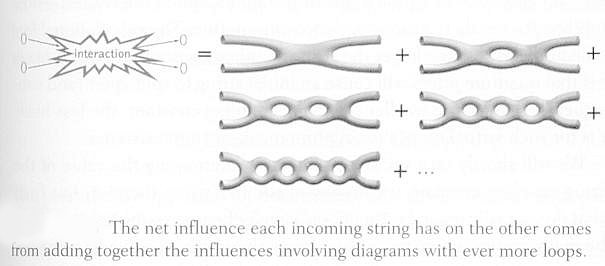 |
Interaction between two strings can be portrayed by a diagram similar to the Feynman diagram for the interaction of two point particles. In place of lines and points in the latter case, the paths of the strings become tubes. The two strings do not meet at a point, they interact by merging (from the incoming) and splitting (to the outgoing). Such a smearing of the interaction avoids the singularity at the point where the two particles meet and thus the theory of string is not plagued by infinities in point particle |
Figure 15-19 Strings Interaction |
quantum field theories. Perturbation theory is used to expand the interaction into a sum of individual diagrams as shown in Figure 15-19. The first one is the main part called tree-level diagram. The others with increasing number of holes are called loop diagrams, they are contributions from virtual particle pairs. If the interaction strength is small, the series would converge rapidly, otherwise calculation becomes increasingly difficult as the number of loops grows.
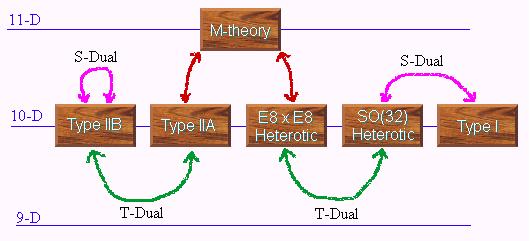
Figure 15-20 Superstrings Theories
| According to the differences in gauge symmetry, kinds of strings or branes, etc. there are five different versions of superstrings theories as shown in Figure 15-20. They are related by the S-duality, which relates the strong coupling limit of one theory to the weak coupling limit of another theory; and the T-duality, which relates a theory which is compactified on a circle with radius R, to another theory compactified on a circle with radius 1/R. |
In 1995, Edward Witten gave evidence for a new, profound kind of duality. He suggested that the five theories, although apparently different in their basic construction, are all just different ways of describing the same underlying physics. The five theories are just five different windows onto this single theoretical framework (in 11-dimensions), which is now called the M-Theory. M-theory contains extended objects of a whole slew of different spatial dimensions called p-brane (an object with p space dimensions, up to nine). It seems the fundamental ingredients in the M-theory are "branes" of a variety of dimensions. The objects in the five theories show up only as strings (or membranes curled up to look like strings), which are light enough to make contact with physics as we know it. The perturbative analyses are not refined enough to discover even the existence of the super-massive extended objects of other dimensions; strings dominated the analyses and the theories was given the name of "string theories".
Currently there is no testable predictions from superstrings. However, it can be shown that at energies below 1016 Gev, the heterotic string theory effectively leads to an ordinary grand unified theory. Meanwhile at this moment, superstrings is the only viable theory that can unify the four interactions (See Figure 15-04), and have the potential to provide explanations for all the fundamental phenomena. It could take the place at the end of the long journey toward the ultimate theory as depicted in Figure 15-05 and 15-06.
Manifold, Vacuum Energy, and Multiverse
Each manifold has an unique potential energy, contributed by fluxes, branes and the curvature of the curled-up dimensions. This energy is called the vacuum energy, because it is the energy of the spacetime when the large four dimensions are completely devoid of matter or fields. The geometry of the small manifold will try to adjust to minimize this energy. As the
Quantum Foam and Loop Quantum Gravity
By combining the laws of quantum mechanics and general relativity, it is deduced that in a region the size of the Planck length (10-33 cm.), the vacuum fluctuations are so huge that space as we know it "boils" and becomes a froth of quantum foam.
 |
In such a scenario, the space appears completely smooth at
the scale of 10-12 cm.; a certain roughness starts to show up at
the scale of 10-30 cm.; and at the scale of the Planck length space becomes a froth of probabilistic quantum foam (as shown in Figure 15-24) and the notion of a simple, continuous space becomes inconsistent. According to the latest idea in superstring theory, the space at such small scale cannot be described by the Cartesian coordinates, x, y and z; it should be replaced by "noncommutative geometry", where the coordinates are represented by non-diagonal matrix. This is essentially the expression of uncertainty principle in quantum mechanics. |
Figure 15-24 Quantum Foam |
A theory to describe space with the size of the Planck length has been developed lately. It is called theory of loop quantum gravity, which postulates that the minimum linear size of space is of the order of the Planck length. Space with larger expanse are built upon this lowest size such that the area and volume are quantized as shown in Figure 15-25. In the loop quantum
Description of a quantum of space can be simplified by representing the
volume with a dot or node, and the area (enclosing the volume) with a line
perpendicular to the face (see Figure 15-26 a and b). The numbers for the node
or line (in Figure 15-26 b) indicate the size of the volume or area. In this
case, the quantum of the volume has eight units of the cubic Planck length.
Figure 15-26 c and d show the connection of two volumes and its representation
in nodes and lines. The network in Figure 15-28 shows the connection of many
discrete volumes; it is called the "spin network". Particles, such as electrons,
correspond to certain types of nodes, which are represented by adding more
labels on the nodes. Field, such as the electromagnetic field, are represented
by additional labels on the lines of the graph.
- An important test is whether classical general relativity can be recovered as an approximation to the loop quantum gravity. It has been shown that long-wavelength gravitational waves propagating on otherwise flat space can be described as excitations of specific quantum states in the loop quantum gravity theory. The theory can also reproduce blackhole radiation and the relationship between blackhole's entropy and its surface area.
- The Planck scale is 16 orders of magnitude below the scale probed in the
highest-energy particle accelerators currently planned (higher energy is
needed to probe shorter distance scales). Thus there seems to be hopeless for
the confirmation of quantum gravity theories.

Figure 15-28 Test
Nevertheless, radiation from distant cosmic explosions called gamma-ray bursts might provide a way to test whether the theory of loop quantum gravity is correct. Gamma-ray bursts occur billions of light-years away and emit a huge amount of gamma rays within a short span. According to loop quantum gravity, each photon occupies a region of lines at each instant as it moves through the spin network. The discrete nature of space causes higher-energy gamma rays to travel slightly faster than lower- energy ones. The difference is tiny, but its effect steadily accumulating during the rays' billion-year voyage. If a burst's gamma rays arrive at Earth in slightly different times according to their energy, that would be evidence for loop quantum gravity (see Figure 15-28). The GLAST satellite, which is scheduled to be launched in 2005, will have the required sensitivity for this experiment.
- Another possible effect of discrete spacetime involves very high energy cosmic rays. It was predicted that cosmic-ray protons with an energy greater than 3x1019 ev would scatter off the cosmic microwave background that fills space and should there fore never reach the Earth. However, more than 10 cosmic rays with energy over this limit were detected in an experiment called AGASA. It turns out that the discrete structure of space can raise the energy required for the scattering reaction, allowing higher-energy cosmic-ray protons to reach the Earth. If the ASASA observations hold up, and if no other explanation is found, then it may turn out that the discreteness of space has already been detected.
- Loop quantum gravity has opened up a new window to investigate deep cosmological questions such as the origin of the universe. Recent loop quantum gravity calculations indicate that the big bang is actually a big bounce; before the bounce the universe was rapidly contracting. A question of similar profundity concerns the cosmological constant. Recent observations of distant supernovae and the cosmic microwave background strongly indicate that it is associated with a positive energy, which accelerates the universe's expansion. Loop quantum gravity has no trouble incorporating this fact into the theory.
- It remains to be shown that classical general relativity is a good approximate description of the loop quantum gravity theory for distances much larger than the Planck length, in all circumstances; and whether special relativity must be modified at extremely high energies (loop quantum gravity indicates that the universal speed of light is only valid for low energy photons).
- Unlike the superstring theory, loop quantum gravity is completely unperturbative and is also background-independent (geometry of spacetime is not fixed), and appears to lead to a pregeometry in which space and time are derived concepts (instead of being a pre-defined entity).
- There is no link between the loop quantum theory and the superstring theory. While the supporters of the former stress the shortcoming of relying on a pre-defined space-time frame (in the superstring theory), and thus will not provide an adequate description of gravitation at small scale; the supporters of the superstring theory point out that the interaction between gravitons and other particles is inconsistent in loop quantum theory. It is suggested that both camps perceive only a small aspect of the whole thing - like the bilind men and the elephant.
Predictions and Tests:
Footnotes
1Inertial systems of reference are either at rest or moving with
constant velocity relative to each other.
2In general, the function of a field F is complex, which can be
decomposed into the form: F = FR + iFI similar to the
complex number c = a + ib. The real part FR and the imaginary part FI
correspond to particle with negative and positive charge respectively.
3It is found that only fermions with left-handed chirality
participates in weak interaction. The chirality in elementary particle is
related to the property of spin. A right-handed particle has its spin oriented
along the particle's direction of motion, while the spin of a left-handed
particle points the other way. All neutrinos are left-handed, and all
antineutrinos are right-handed (if the neutrino mass is
strictly zero). Other particles can exist in either state.
4Parity is about the behaviour of the field upon the reversal of the
coordinate (x,y,z) to (-x,-y,-z). Even or odd parity refers to the case when the
field remains unchanged or just change a sign. It has been long held that parity
is conserved for all physical processes. In other word, the overall parity (for
the participating particles) after an interaction should be the same as the
initial one. This simple rule is very useful for selecting permissible processes.
With some hints from experimental results, T.C. Lee and C.N. Yang
pointed out that conservation of parity may be violated in weak interaction. A
test was arranged by C. S. Wu to observe the beta decay of cobalt-60 in a
magnetic field. It shows a preferred direction for the emitting electrons (the
left-handed electrons) and thus validates the hypothesis of parity violation for
weak interaction -- the mirror world behaves differently from the real world.
5In the summer of 1953 C. N. Yang and Robert Mills (a graduate
student at that time) invented the SU(2) gauge theory that has become synonymous
with their names. They did not immediately publish their results because they
were aware of the difficult problems posed by the gauge-field masses and
renormalization. After studying these problems for some time and realizing that
they would not be solved in the short term, they sent their paper for
publication in the spring of 1954. The problems were eventually resolved twenty
years later in a modern version called the Standard Model.
6The transition is similar to water frozen to ice, the Higgs fields
move away from a state with higher symmetry to a state without this symmetry but
in lower energy. This is called spontaneous symmetry breaking. It is related to
the fact that although the system has certain symmetry as portrayed in the "Action",
the field itself needs not to possess the same kind of symmetry. According to
GUT (Grand Unified
Theory), the transition occurred at about 10-37 sec after the Big
Bang when temperature was 1029 oK corresponding to 1016
Gev.
- Particle Physics -- http://www.rishi.dk/reality/quantum/quantum.html
- Fermilab's Tevatron in Details -- http://www-bd.fnal.gov/public/synchrotrons.html#Magnets>http://www-bd.fnal.gov/public/synchrotrons.html#Magnets</a></li><li>Particle Chart -- <a href=
- Elementary Particles -- http://sol.sci.uop.edu/~jfalward/elementaryparticles/elementaryparticles.html
- Fundamental Interactions -- http://zebu.uoregon.edu/~js/ast123/lectures/lec09.html
- Extra-dimension and String Theory -- http://superstringtheory.com/experm/exper5a.html
- History of Physics -- http://physics.hallym.ac.kr/education/history.html
- Relativity -- http://www.physics.fsu.edu/Courses/Spring98/AST3033/Relativity/GeneralRelativity.htm
- Quantum Field Theory -- http://xxx.lanl.gov/abs/hep-th/9702027
- Standard Model -- http://superstringtheory.com/experm/exper2a.html
- S-matrix -- http://www.pact.cpes.sussex.ac.uk/users/markh/RQF1/node36.html
- Feynman Diagram -- http://www2.slac.stanford.edu/vvc/theory/feynman.html
- Feynman Diagram, Animations -- http://www.departments.bucknell.edu/physics/animations/Feynman_diagrams/index.html
- Supersymmetry -- http://www.cerncourier.com/main/article/40/10/19
- Supersymmetry -- "Physics Beyond the Standard Model", Gordon Kane, Scientific American, Volume 288, Number 6, June 2003, pp 68-75.
- Superstrings -- http://www.sukidog.com/jpierre/strings/
- Superstrings, the Second Revolution -- http://www.theory.caltech.edu/people/jhs/strings/
- M-Theory -- http://www.damtp.cam.ac.uk/user/gr/public/qg_ss.html
- Quantum Gravity, Overview -- http://www.utdallas.edu/~loper/research/19980422.pdf
References:
Index
| Abelian group Accelerators Asymptotic freedom Bare mass Baryon Beta decay Calabi-Yau space CERN, LHC Charge Carriers Colour charge Compactification Cosmic rays Einstein, Albert Electroweak interaction Elementary particles Fermi, Enrico Fermilab Tevatron Fermion generations Feynman diagram Field equation Fundamental interactions Gauge boson Gauge invariance General theory of relativity Geodesic Ghosts Gluon Grand Unified Theory (GUT) Graviton Gravity Green's function Hardon Heterotic superstring Hierarchy problem Higgs field Higgs mechanism Lee, T. D. and Yang, C. N. Loop quantum gravity Manifold Manyfold universe Maxwell, J. C. |
Meson M-theory Newton, Isaac Neutrino Non-Abelian group Parity violation P-brane Perturbation method Quantum Chromodynamics (QCD) Quantum domain Quantum electrodynamics (QED) Quantum field theory Quark Quark confinement Renormalization S-duality Second quantization Sheldon Glashow, Abdus Salam, Steven Weinberg S matrix Special theory of relativity Spontaneous symmetry breaking Standard model Strong residual interaction SU(2) SU(3) SU(5) Super-gravity Superpartners Superstrings Supersymmetry Tachyon T-duality Theory Of Everything (TOE) Topology U(1) Unifications, A Brief History of Physcis Vacuum polarization W bosons World-sheet X bosons Yukawa, H. |
Alıntı: http://universe-review.ca/F15-particle.htm
[Home Page] - Quantum and atom- Quantum Worlds
Wormhole, Time Travel, Time Machine, Zamanda Yolculuk, Zaman Makinası, Warp drive, UFO, Antigravity, Free energy, kurt deliği, Teleportation, Wormhole, Quantum field theory
Hiçbir yazı/ resim izinsiz olarak kullanılamaz!! Telif hakları uyarınca bu bir suçtur..! Tüm hakları Çetin BAL' a aittir. Kaynak gösterilmek şartıyla siteden alıntı yapılabilir.
The Time Machine Project © 2005 Cetin BAL - GSM:+90 05366063183 -Turkiye/Denizli
Ana Sayfa /index /Roket bilimi /![]() E-Mail /CetinBAL/Quantum Teleportation-2
E-Mail /CetinBAL/Quantum Teleportation-2
Time Travel Technology /Ziyaretçi Defteri /UFO Technology/Duyuru
